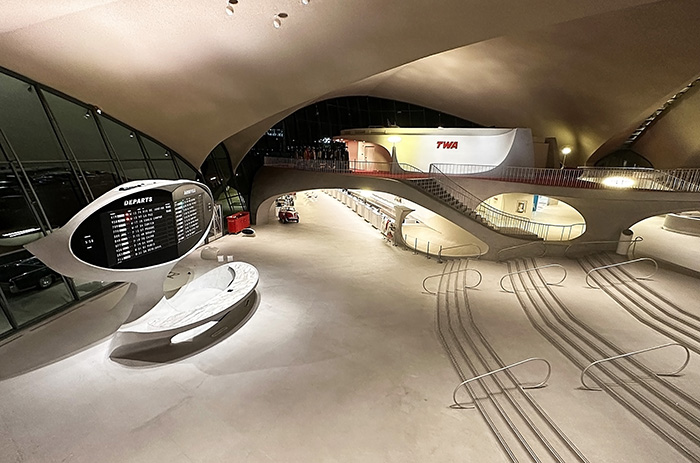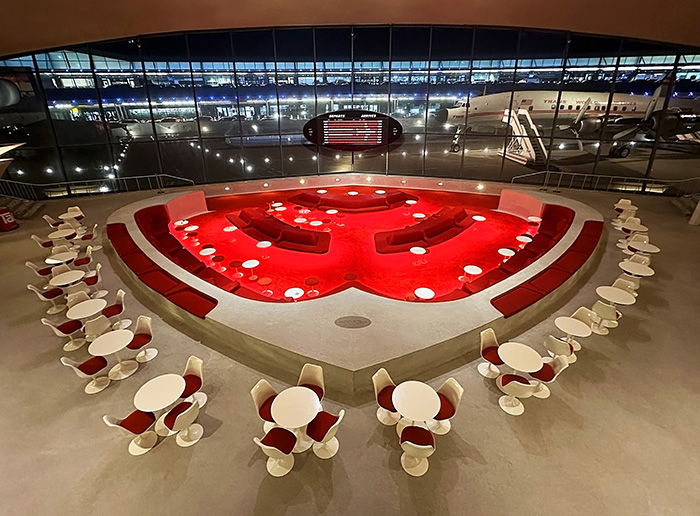Airport hotels typically aren’t known for their style or elegance. They’re meant to be places to stay before or after a flight — or for taking a nap and freshening up during a lengthy layover. The TWA Hotel at New York City’s John F. Kennedy International Airport is all that — and so much more. In fact, it’s not just a hotel, it’s a midcentury modern masterpiece. And it’s a must-stay destination if you’re visiting New York City.
From TWA Flight Terminal to TWA Hotel
The TWA Hotel started life as the landmark flight center for Trans World Airlines, one of the most iconic airlines of the 20th century. In 1956, TWA owner Howard Hughes commissioned Eero Saarinen to design the building. The Finnish-American architect is celebrated for his neo-futuristic style. He is renowned for such famous structures as the St. Louis Gateway Arch and Washington Dulles International Airport. And his Tulip Chair, Pedestal Table, and Womb Chair are mainstays of midcentury modern interior design.
Opened in 1962, when JFK was called Idlewild Airport, the flight center was Saarinen’s magnum opus. It was unlike any other airline terminal. At the time, terminals were minimal and businesslike. The innovative TWA building was the epitome of midcentury modern design. It was known as the “Grand Central of the Jet Age.”
When the terminal first opened, 11.5 million people passed through JFK. With the advent of the Boeing 747 in 1970, however, that number increased dramatically. Saarinen’s creation could not handle the growing traffic. By 1992, more than 25 million people passed through the airport.
The airline shuttered in 2001, and as a result, so did the terminal. It sat empty for nearly two decades. Although the building was listed as a NYC landmark, it frequently was threatened with demolition. But in 2005, it listed on the National Register of Historic Places.
In 2017, Jet Blue, the Port Authority of New York and New Jersey, and the State of New York decided to restore the TWA flight center and turn it into a hotel. The entire building was painstakingly renovated and upgraded. Original details, such as the check-in counters, restaurant, and sunken lounge were retained. Furnishings, finishes, and fabrics were re-created. The space remains nearly identical to its original form.
In May 2019, the TWA Hotel opened its doors to its first customers.

A Marvel of Modern Architecture
“Once one embarks on a concept for a building, this concept has to be exaggerated and overstated and repeated in every part of its interior so that wherever you are inside or out, the building sings with the same message,” Saarinen said. He succeeded with the TWA flight center.
Unfortunately, the architect died in 1961 — one year before construction on the terminal was completed.
The building’s iconic swooping roofline is instantly recognizable. Saarinen wanted the facade to mirror the shape of bird with its wings spread.
The dramatic liquid curves continue inside. There are no square corners in the entire 1960s building. Sweeping staircases flow throughout the cavernous main atrium. The groin-vaulted white ceiling, circular archways, and curved walls lend a relaxing and seductive — yet space-agey — vibe. And sloped floor-to-ceiling windows once allowed passengers to enjoy views of departing and landing planes.
The terminal was one of the first in the world to offer covered jetways and baggage carousels. Both elements are on display in the hotel. And, like it was in the 1960s, the stark white interior is accented with pops of Chili Pepper Red, also known as TWA Red.
During the restoration, two seven-story towers were added. They flank the original flight center and are linked by the tubular walkways. These wings house 512 guest rooms. Most rooms offer views of either the airport runways or the iconic flight center.

Staying at the TWA Hotel
The TWA Hotel is my favorite place to stay whenever I visit NYC. It’s my go-to spot for my last night in the city. I love the fact that it’s just steps from the terminals. I can book an early flight back to Arizona and not have to worry about waking up extra early to catch a ride from Manhattan to the airport in morning traffic.
I’m also in awe of its design. As an architecture buff and midcentury design enthusiast, I get chills every time I walk down the long, red-carpeted flight tubes that lead to the hotel. The experience is akin to something out of a science fiction or Stanley Kubrick movie.
I always choose to stay in a Deluxe King with Historic TWA View room. I love opening the curtains and seeing Saarinen’s masterpiece. The rooms are relatively small, with just enough floor area to walk around the bed, but this is New York, so space is at a premium. The bed sits in the middle of the room, and the back of the headboard is a long built-in desk. Instead of the typical pen, a cup of TWA pencils is available for use.
The rooms are outfitted with authentic Saarinen-designed furnishings by Knoll, including a Womb Chair. A large TV swivels from the wall for easy viewing from your bed. And the floor-to-ceiling windows are 4.5 inches thick and consist of seven panes, so you don’t hear anything from the nearby runways.
The gleaming white bathrooms are small but functional. The floors are period-correct terrazzo. Toiletries are TWA branded. And plush TWA bathrobes are provided for extra comfort. But you’re not going to want to stay in your room. The hotel has much more to offer.

Dining Midcentury Style
Anyone who has seen photos of the TWA Hotel will recognize the sunken lounge. Crowds gathered here in 1965 to watch the Beatles arrive in the U.S. The parabolic-shaped red lounge remains a great place to hang out and people watch. Guests can also enjoy bar food, such as flatbreads, nachos, and sliders, and cocktails while a split flap departure board by Solari di Udine displays playful messages. Reservations are not required, and you don’t need to order food in order to relax in style.
A food hall to the right of the entrance offers quick bites for folks on the go, including bagels, paninis, hot dogs, fruit cups, chips, and soft drinks. Intelligentsia Coffee has a coffee bar across from the check-in counters.
For more refined dining, head upstairs to Paris Café by Jean-Georges. The space is outfitted with Saarinen-designed Pedestal Tables and Tulip Chairs in shades of cream and pink. The menu is not as haute cuisine as other Jean-Georges restaurants, but it includes hints of the famed chef’s signature dishes, including Crispy Salmon Sushi and Wagyu Beef Tenderloin.
I enjoy the Rigatoni with Meatballs. The pasta is expertly cooked and the smoked chili tomato ragu is rich and flavorful. Portion sizes are small, and prices are on the high side — although you must remember that this is still an airport hotel. The restaurant is open daily for breakfast, lunch, and dinner, and reservations are highly recommended.
End your day with a tipple on “Connie,” a 1958 Lockheed Constellation once owned by Hughes. The historic airplane sits outside the terminal and can be viewed from the sunken lounge. Cocktails have fun aviation-themed names, such as Paper Plane, Vodka is My Co-Pilot, and Mile-High Margarita. Connie is open daily from 4-10:30 p.m.

Made for Instagram
Take some time during your stay to explore the hotel. Around every corner is a new and fun discovery, all of which offer endless social media photo opps.
Vintage vehicles welcome guests at the front entrance. More are parked inside. In the lobby, you’ll find the Twister room and the Tiki-chic blue interactive Sixties Living Room. Down one flight tube, you’ll find a re-creation of Hughes’ office. Down the other is a re-creation of Saarinen’s drafting studio. There’s even a life-size Barbie Dreamhouse room, filled with far-out furnishings.
More than 2,000 historic artifacts are exhibited throughout the hotel. On the second level, a museum exhibit showcases TWA uniforms dating from 1945 through 2001. Every wall is decorated with vintage posters, architectural drawings, and historical photos. More uniforms and airline dining service items are on display on the ground floor near the conference and event spaces.
And while I didn’t get a chance to experience these, there are also a curling rink, 10,000-square-foot fitness center, and a rooftop swimming pool and bar.

If You Go
The TWA Hotel is located at JFK’s Terminal 5. Inbound passengers can access the terminal via the airport’s AirTrain. If you’re coming from NYC or outside locations, you can take the subway or Long Island Railroad to the Howard Beach or Jamaica stations and transfer to the AirTrain. While AirTrain transfers between terminals are free, if you’re entering or leaving the train at Howard Beach or Jamaica, you’ll need to purchase an $8 MetroCard at one of the many vending machines available at the turnstiles.
In addition to overnight accommodations, the hotel offers Daytripper stays. Stop over for four to 12 hours, between 6 a.m. and 8 p.m.
Overnight rates begin at about $294/night and can go upwards of $1,000/night for the Howard Hughes Suite. Daytripper rates run about $164. The TWA hotel also is pet friendly. There is a $65 per pet per day fee. Parking also is available for a fee. You can visit Expedia, Hotels.com, or your favorite online booking site to see if they offer better rates for an overnight stay and make your reservation there.
Whether you’re staying for the night or just stopping by for a cocktail before heading to your flight, the TWA Hotel is a must-see destination for anyone who loves architecture or design — or who simply wants to experience some midcentury nostalgia. I only wish it was in Manhattan so I could spend multiple days enjoying this amazing piece of history.
If midcentury modern isn’t your style, check out these great art deco hotels in New York City.
All photos by Rebecca L. Rhoades

